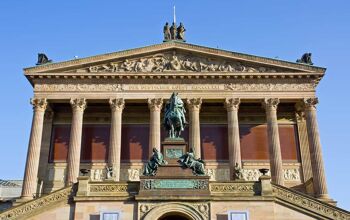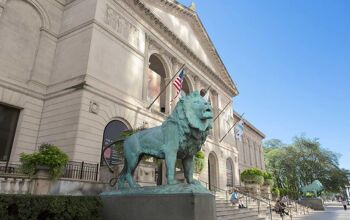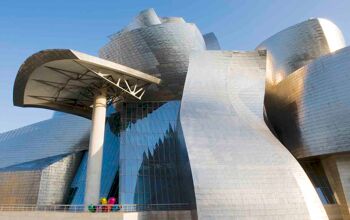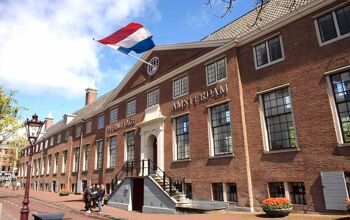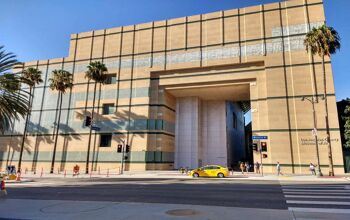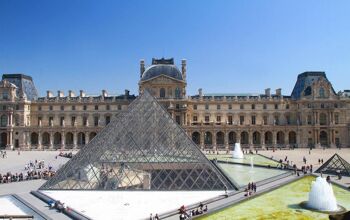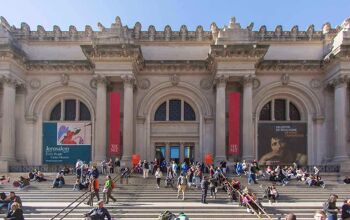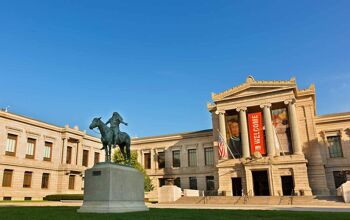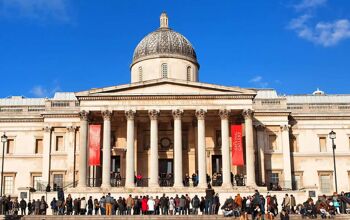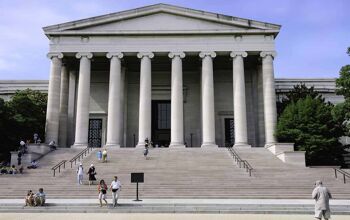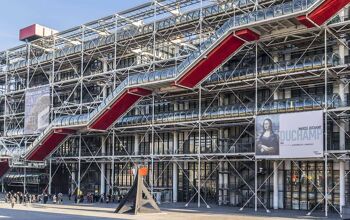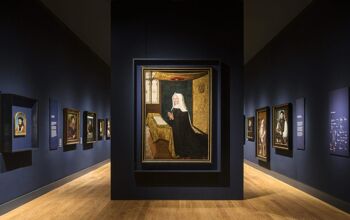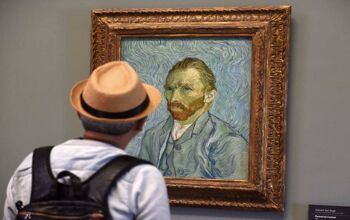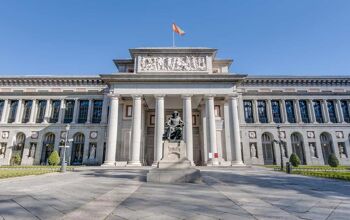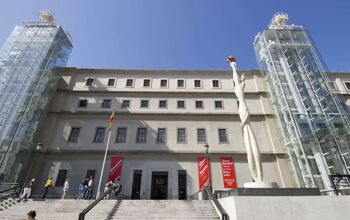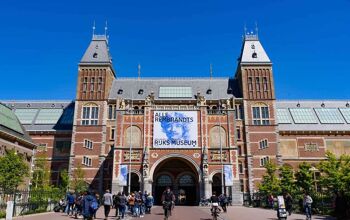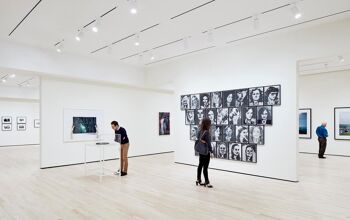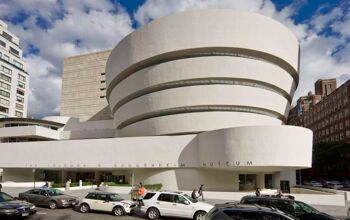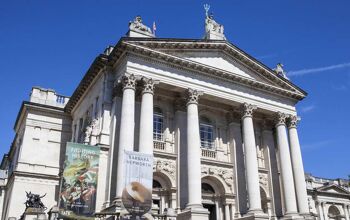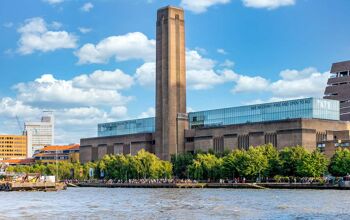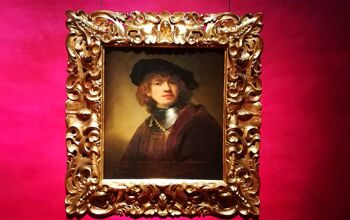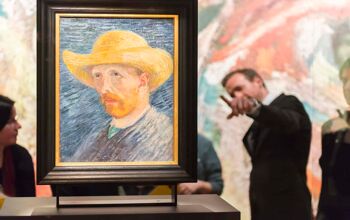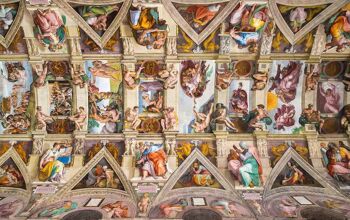What are the 20 most important styles of art (in chronological order)?
1. Gothic Art (12th Century)
Originating in Northern France, Gothic art is known for its intricate and elongated figures, focusing on religious themes. Stained glass, frescoes, and sculptures are prevalent in Gothic art, with famous examples like Notre Dame de Paris and Chartres Cathedral’s stained glass windows.
2. Renaissance (15th-16th Centuries)
Renaissance art, beginning in Italy, marks a cultural rebirth with a focus on realism, proportion, and perspective. It’s renowned for lifelike human figures and detailed landscapes, and characterised by detailed human anatomy and rich colour palettes. Its most famous artists are Leonardo da Vinci and Michelangelo. Leonardo da Vinci’s ‘Mona Lisa’ and Michelangelo’s Sistine Chapel frescoes are iconic works.
3. Baroque (Early 17th Century)
Emerging in Europe, Baroque art is dramatic, with rich colours and intense contrasts between light and shadow. It’s known for its emotion-evoking, detailed, and dynamic compositions. Caravaggio and Peter Paul Rubens were the most notable Baroque artists. Caravaggio’s ‘The Calling of St Matthew’ and Rembrandt’s ‘The Night Watch’ are seminal works.
4. Neo-Classicism (Mid-18th Century)
Neo-Classicism, inspired by classical art and culture, is known for its simplicity, symmetry, and grandeur – a reaction to the Baroque and Rococo styles. Its most famous works are Jacques-Louis David’s ‘Oath of the Horatii’ and ‘Death of Marat’ showcasing clean lines and moral seriousness.
5. Romanticism (Late 18th Century)
Romanticism favoured emotion, individualism, and nature, often depicting awe-inspiring landscapes and heroic figures. Eugène Delacroix and J.M.W. Turner are two of the most famous Romantic painters. Its most notable works include Eugène Delacroix’s ‘Liberty Leading the People’ and Caspar David Friedrich’s ‘Wanderer above the Sea of Fog’.
6. Realism (Mid-19th Century)
Realism focuses on depicting everyday subjects and ordinary people, eschewing the grandiose subjects of Romanticism. Gustave Courbet’s ‘The Stone Breakers’ and Jean-François Millet’s ‘The Gleaners’ are prime examples, showcasing true-to-life representation without idealisation.
7. Impressionism (1860s)
Originating in France, Impressionism features small, visible brushstrokes, open composition, and an emphasis on light. It captures scenes’ essence rather than details, with Claude Monet and Edgar Degas as key Impressionist painters. Claude Monet’s ‘Impression, Sunrise’ and Edgar Degas’s ‘Ballet Dancers’ most famously exemplify this style, known for their light portrayal and outdoor scenes.
8. Post-Impressionism (Late 19th Century)
Post-Impressionism includes various styles focusing on more symbolic content, structure, and formal order. Vincent van Gogh, Paul Gauguin and Paul Cézanne are mostly famously associated with this movement. Van Gogh’s ‘Starry Night’ and Cézanne’s ‘Mont Sainte-Victoire’ series are significant, exhibiting more abstract and geometric forms.
9. Art Nouveau (Late 19th Century)
Characterised by intricate linear designs and flowing curves based on natural forms, Art Nouveau is notable in decorative art, architecture, and design. Alphonse Mucha’s posters and Antoni Gaudí’s architectural masterpieces, notably the Sagrada Familia, are iconic, featuring ornate, organic shapes.
10. Fauvism (Early 20th Century)
Fauvism is known for its vivid, non-naturalistic colours. Henri Matisse is the most renowned Fauvist, emphasizing strong colour over the realistic depiction. His ‘The Woman with the Hat’ and André Derain’s ‘London Bridge’ are key works, showcasing the style’s bold, vibrant palette.
11. Expressionism (Early 20th Century)
Expressionism, originating in Germany, emphasizes the representation of emotions over reality. Edvard Munch’s ‘The Scream’ and Egon Schiele’s self-portraits are notable, characterised by distorted forms and intense colours.
12. Cubism (Early 20th Century)
Developed by Pablo Picasso and Georges Braque, Cubism breaks objects into abstract, geometric forms, often using multiple perspectives and fragmented shapes. Picasso’s ‘Les Demoiselles d’Avignon’ and Braque’s ‘The Portuguese are landmark works, showing fragmented and abstracted forms.
13. Dadaism (Early 20th Century)
Dadaism, a response to World War I, is characterized by absurdity and cynicism. It challenges traditional aesthetics and is known for its anti-war stance. Marcel Duchamp’s ‘Fountain’ and Hannah Höch’s photomontages exemplify its anti-art stance, challenging traditional aesthetics.
14. Art Deco (1920s and 1930s)
Art Deco combines modern styles with fine craftsmanship and rich materials, characterised by geometric patterns and bold colours. It is associated with luxury and exuberance. The Chrysler Building in New York and Tamara de Lempicka’s ‘Self-Portrait in the Green Bugatti’ are emblematic of its lavish and streamlined aesthetic.
15. Surrealism (1920s)
Surrealism, characterized by bizarre, dream-like imagery, aims to channel the unconscious. Salvador Dalí and René Magritte are Surrealism’s most famous sons. Dalí’s ‘The Persistence of Memory’ and René Magritte’s ‘The Son of Man’ are iconic works, showcasing surreal, fantastical scenes.
16. Constructivism (1913)
Originating in Russia, Constructivism combined art and technology, advocating for art as a practice for social purposes. Vladimir Tatlin’s ‘Monument to the Third International’ and Aleksander Rodchenko’s graphic designs are key works, characterised by abstract geometric forms and industrial materials.
17. Abstract Expressionism (1940s)
Originating in New York, this style emphasizes gestural brushstrokes and the impression of spontaneity. Jackson Pollock (‘Autumn Rhythm’) and Mark Rothko (‘Orange, Red, Yellow’) are key figures.
18. Minimalism (1960s)
Minimalism features simple, geometric forms and often monochromatic colour schemes, emphasising extreme simplicity and stripping art of personal expression. Donald Judd and Agnes Martin are notable Minimalists. Key works include Judd’s ‘Untitled’ (1969) and Martin’s ‘Morning’ (1965).
19. Pop Art (1950s)
Pop Art uses images of popular culture, often in a graphic style derived from commercial art. It blurs the line between commercial and fine art. Andy Warhol is the movement’s most famous artist. His ‘Marilyn Diptych’ and Roy Lichtenstein’s comic strip paintings are iconic examples.
20. Surrealist Photography (20th Century)
Extending surrealism to photography, this movement creates bizarre, dream-like images, manipulating photos to distort reality. Man Ray is a notable artist, known for his innovative techniques and enigmatic compositions.
What are the world’s greatest artworks?
See our round-up of the world’s greatest artworks.
Who are the world’s most famous painters?
See our summary at the bottom of our round-up of the world’s greatest artworks.
Where are the best destinations to go to for art lovers?
See our round-up of the world’s best destinations for seeing world-class art.


